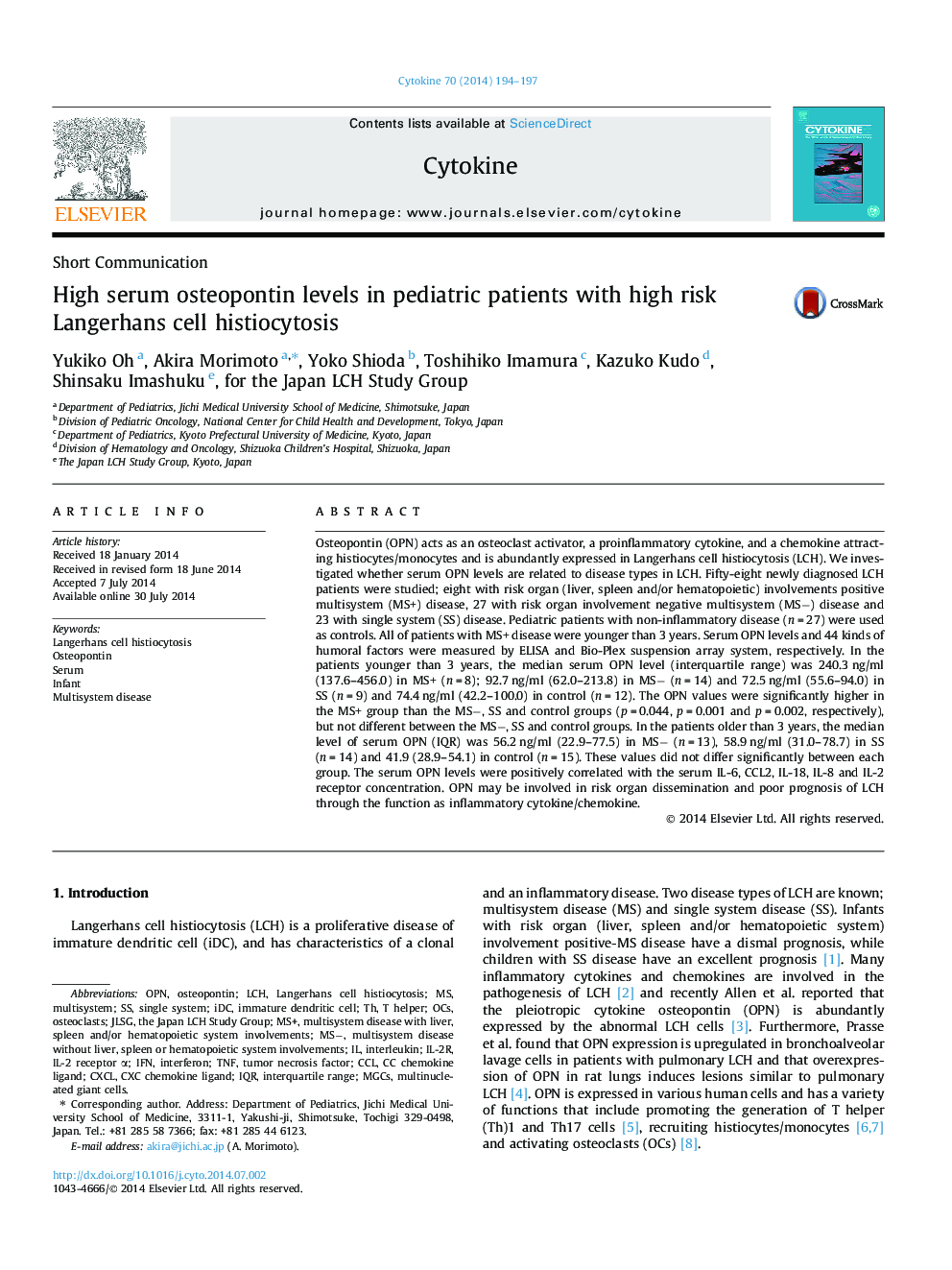| کد مقاله | کد نشریه | سال انتشار | مقاله انگلیسی | نسخه تمام متن |
|---|---|---|---|---|
| 5897097 | 1568736 | 2014 | 4 صفحه PDF | دانلود رایگان |
عنوان انگلیسی مقاله ISI
High serum osteopontin levels in pediatric patients with high risk Langerhans cell histiocytosis
ترجمه فارسی عنوان
سطح استئوپونتیم سرم در بیماران کودکان مبتلا به هیستوسیتوز سلول های لانگرهانس با خطر بالا است
دانلود مقاله + سفارش ترجمه
دانلود مقاله ISI انگلیسی
رایگان برای ایرانیان
کلمات کلیدی
LCHMGCsTNFMultisystemT helperIL-2RCXCLOPNCCLIDCOCsIQROsteopontin - استئوپنتینOsteoclasts - استخوانکاه interferon - اینترفرونIFN - اینترفرون هاinterleukin - اینترلوکینMultisystem disease - بیماری چند بیماریSerum - سرمImmature dendritic cell - سلول دندریتیک نامرغوبMultinucleated giant cells - سلول های غول پیکر چند هسته ایSingle system - سیستم واحدtumor necrosis factor - فاکتور نکروز تومورCXC chemokine ligand - لیگاند شیمیایی CXCCC chemokine ligand - لیگاند کیموکین CCinterquartile range - محدوده بین محدبInfant - نوزادLangerhans cell histiocytosis - هیستوسیتوز سلول لانگرهانس
موضوعات مرتبط
علوم زیستی و بیوفناوری
بیوشیمی، ژنتیک و زیست شناسی مولکولی
علوم غدد
چکیده انگلیسی
Osteopontin (OPN) acts as an osteoclast activator, a proinflammatory cytokine, and a chemokine attracting histiocytes/monocytes and is abundantly expressed in Langerhans cell histiocytosis (LCH). We investigated whether serum OPN levels are related to disease types in LCH. Fifty-eight newly diagnosed LCH patients were studied; eight with risk organ (liver, spleen and/or hematopoietic) involvements positive multisystem (MS+) disease, 27 with risk organ involvement negative multisystem (MSâ) disease and 23 with single system (SS) disease. Pediatric patients with non-inflammatory disease (n = 27) were used as controls. All of patients with MS+ disease were younger than 3 years. Serum OPN levels and 44 kinds of humoral factors were measured by ELISA and Bio-Plex suspension array system, respectively. In the patients younger than 3 years, the median serum OPN level (interquartile range) was 240.3 ng/ml (137.6-456.0) in MS+ (n = 8); 92.7 ng/ml (62.0-213.8) in MSâ (n = 14) and 72.5 ng/ml (55.6-94.0) in SS (n = 9) and 74.4 ng/ml (42.2-100.0) in control (n = 12). The OPN values were significantly higher in the MS+ group than the MSâ, SS and control groups (p = 0.044, p = 0.001 and p = 0.002, respectively), but not different between the MSâ, SS and control groups. In the patients older than 3 years, the median level of serum OPN (IQR) was 56.2 ng/ml (22.9-77.5) in MSâ (n = 13), 58.9 ng/ml (31.0-78.7) in SS (n = 14) and 41.9 (28.9-54.1) in control (n = 15). These values did not differ significantly between each group. The serum OPN levels were positively correlated with the serum IL-6, CCL2, IL-18, IL-8 and IL-2 receptor concentration. OPN may be involved in risk organ dissemination and poor prognosis of LCH through the function as inflammatory cytokine/chemokine.
ناشر
Database: Elsevier - ScienceDirect (ساینس دایرکت)
Journal: Cytokine - Volume 70, Issue 2, December 2014, Pages 194-197
Journal: Cytokine - Volume 70, Issue 2, December 2014, Pages 194-197
نویسندگان
Yukiko Oh, Akira Morimoto, Yoko Shioda, Toshihiko Imamura, Kazuko Kudo, Shinsaku Imashuku, for the Japan LCH Study Group for the Japan LCH Study Group,
